-
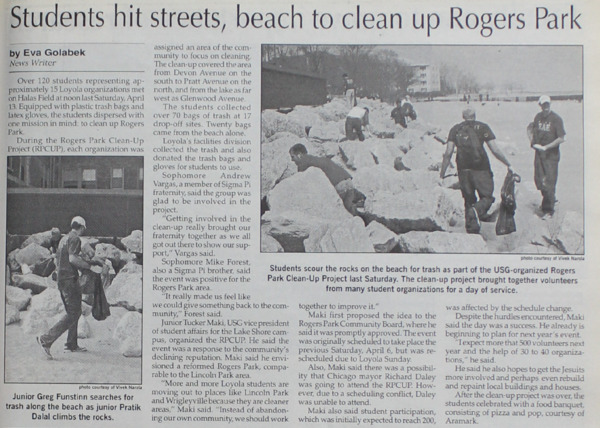
Over 120 students from about 15 Loyola organizations worked together to clean up Rogers Park during the student-initiated Rogers Park Clean-Up Project (RPCUP), begun as a response to the worsening reputation of the community. Each organization focused on a pre-assigned area to clean. The clean-up spanned Devon Avenue on the south to Pratt Avenue on the north, and from the lake as far west as Glenwood Avenue. In total, students collected over 70 bags of thrash, with 20 bags coming from the beach alone. The article also describes plans for future iterations of the project, which include conducting the project at a larger scale and having greater involvement from the Jesuits in possibly rebuilding and repainting local houses and buildings. There are also two images of students cleaning the beach.
-
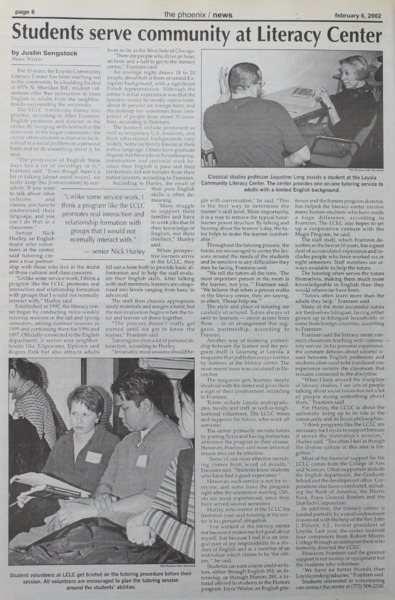
This article describes the work of the Loyola Community Literacy Center. Established in 1992, the Loyola Community Literacy Center (LCLC) on the Lake Shore Campus offered free tutoring in basic English to adults from neighborhoods around the university; it has also had interested participants from as far as the West Side of Chicago. The center began by conducting twice-weekly sessions during the semester and gradually branched into offering sessions over the summer as well. The center’s tutors included Loyola undergraduates, faculty, staff, and neighborhood volunteers. Prospective learners, many of whom hear about the center through word of mouth, are assigned a tutor after an initial assessment, and both work together in a learner-centered process, with lessons built around learners’ needs. Another form of partnership between learner and the LCLC is Learning at Loyola, a magazine publishing essays written by learners. Student tutors reflected that the sessions also made them “much more knowledgeable in English than they would otherwise have them. The article also features two images, one of Classical studies professor Jacqueline Long working with a learner (top), and the other of student tutors being briefed at orientation (bottom)
-
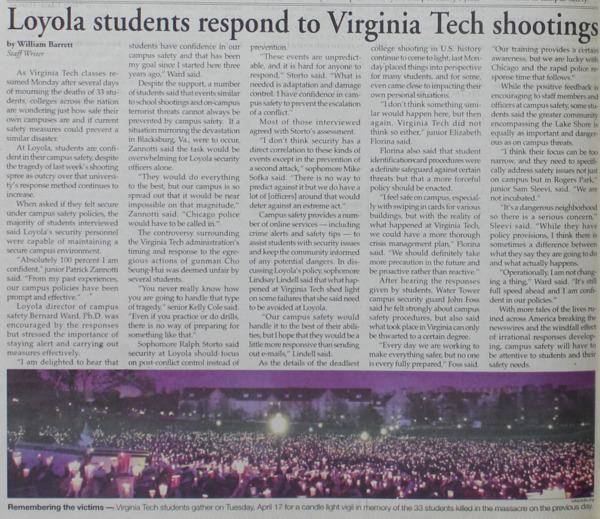
An article by William Barret discusses student responses to the Virginia Tech shootings that had occurred earlier in April. The author concluded that Loyola students were confident in campus safety. A number doubted whether anything like that could be prevented at all. Some felt that the campus ID swiping procedure helped increase safety but that there should be more measures in place. Security personnel discussed the challenges of being in a major city.
A photograph depicts a candlelight vigil held at Virginia Tech on April 17 for the 33 students who had been killed the previous day.
-
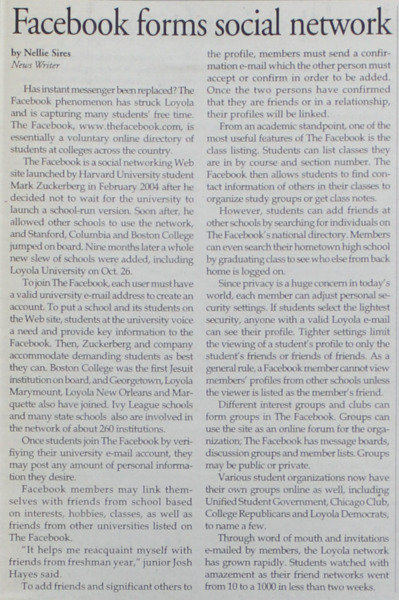
An article in the Loyola Phoenix by Nellie Sires covers the new website, www.thefacebook.com, which was "essentially a voluntary online directory of students at colleges across the country." Mark Zuckerberg launched in in February 2004 and other schools were added later. Loyola University was added on October 26.
According to the article, "To join The Facebook, each user must have a valid university e-mail address to create an account." Several other Jesuit schools had already joined. "Once students join The Facebook by verifying their university e-mail account, they may post any amount of personal information they desire.
Facebook members may link themselves with friends from school based on interests, hobbies, classes, as well as friends from other universities listed on The Facebook.
'It helps me reacquaint myself with friends from freshman year,' junior Josh Hayes said.
To add friends and significant others to their profile, members must send a confirmation e-mail which the other person must accept or confirm in order to be added. Once the two persons have confirmed that they are friends or in a relationship, their profiles will be linked.
From an academic standpoint, one of the most useful features of The Facebook is the class listing. Students can list classes they are in by course and section number. The Facebook then allows students to find contact information of others in their classes to organize study groups or get class notes."
The article mentions students being able to search for former classmates across the country, adjust privacy settings, and join interest groups. Several student organizations had created groups on The Facebook. "Students watched with amazement as their friend networks went from 10 to a 1000 in less than two weeks."
Item 1: Full article
Item 2: Detail of first paragraph
-

A student speaks at a microphone while other students sit on risers in the background onstage during a production of The Vagina Monologues at Loyola. The Gannon Scholars were involved with productions of this show for several years.
-
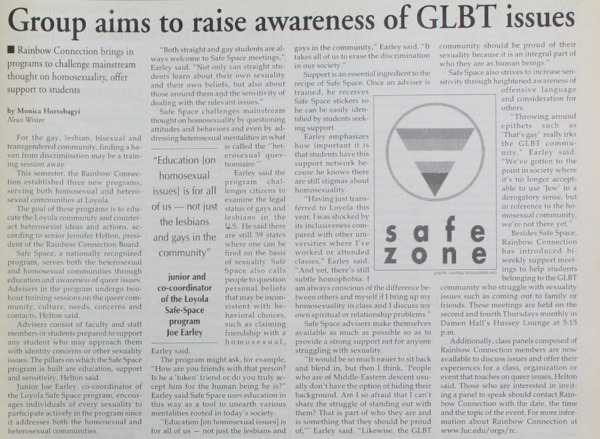
An article by Monica Hortobagyi discusses the Rainbow Connection, an organization at Loyola that aimed to create a haven from discrimination "for the gay, lesbian, bisexual, and transgendered community." They established three new programs at Loyola to serve "both homosexual and heterosexual communities at Loyola." Safe Space, a nationally recognized program, provided education and awareness of queer issues led by advisers, who were trained faculty, staff, or students. One of the topics they focused on was the legal status of gay and lesbian people in states across the U.S.
Rainbow Connection also offered bi-weekly support meetings to help students belonging to the GLBT community, as well as class panels that could be invited to speak for an audience.
-
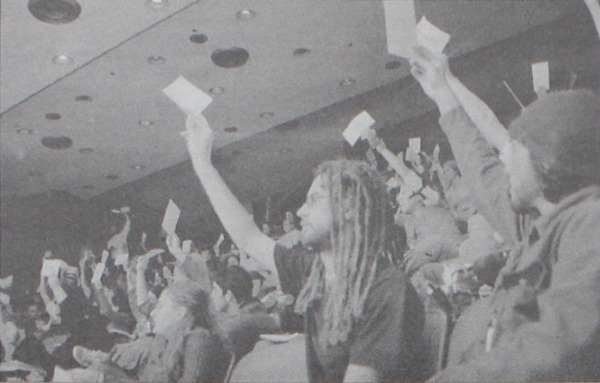
A photo taken by The Phoenix's John Burnham appears in an article titled "Antiwar group convenes" by April Otterberg. The photo shows students sitting in an auditorium raising paper slips into the air. The caption reads: "Student activists from across the country met at Loyola for a weekend conference to discuss issues surrounding a war in Iraq and to organize the structure of their new national student organization, Campus Antiwar Network." The Loyola Anti-War Network (LAWN) hosted a conference of over 300 students from CSAWN, the Chicago Student Anti-War Network. CSAWN was part of CAN, the Campus Antiwar Network, which the article describes as having been formed on January 17, 2003 at regional conferences at George Washington University and San Francisco State University "to find ways to strengthen the antiwar movement" as a war in Iraq seemed more and more likely. At those two conferences, delegates from over 70 colleges "voted to oppose the war on Iraq and educate and activate [their] classmates and campus communities." LAWN reserved the Galvin Auditorium and members looked forward to being part of such a large movement, which the article says was the largest of its kind since the anti-Vietnam War movement.
At the conference at Loyola, nearly 200 delegates from 100 universities and colleges (and five high schools) voted on issues concerning the structure and mission statement of the movement and future antiwar actions. About 150 guests also attended. The group agreed to also call for an end to racism, especially racial profiling and ethnic scapegoating, to protect civil liberties, and to push for the funding of education and jobs instead of war. They voted to divide the country into five regions with two delegates each and include a delegate for high school representation to act as the national leadership. The group planned National Days of Action and hoped to organize campus actions across the country. At Loyola, LAWN met at 3pm on Mondays in the Commuter Lounge on the second floor of the Centennial Forum Student Union.
-
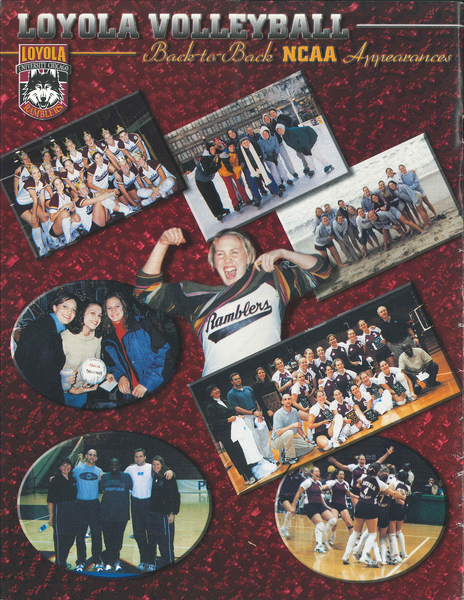
A collage features photos of the Loyola Ramblers women's volleyball team on the court and posing as a group, in celebration of two years in which they appeared in the NCAA tournament.
-

This is a collage of eight Loyola students' responses to 9/11. Their reactions ranged from shock and sadness at the devastation to concern about the possibility of a draft for college students.
-
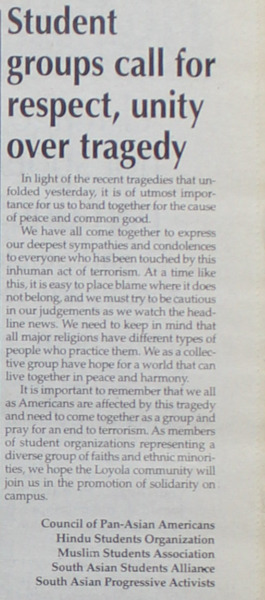
This article is a joint statement calling for solidarity on Loyola’s campus in the wake of 9/11. The statement was issued by Loyola’s faith-based and ethnic minority student organizations, the Council of Pan-Asian Americans, the Hindu Students Organization, the Muslim Students Association, the South Asian Students Alliance, and the South Asian Progressive Activists.
-
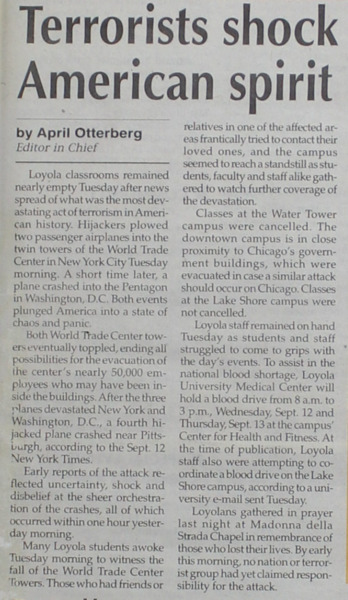
This article describes Loyolans’ reactions in the wake of 9/11 and the impacts of 9/11 on campus operations. Although classes continued at the Lake Shore Campus, classes at the Water Tower Campus were cancelled due to the building’s close proximity to Chicago’s government buildings. Blood drives were also planned to address the national blood shortage.
-
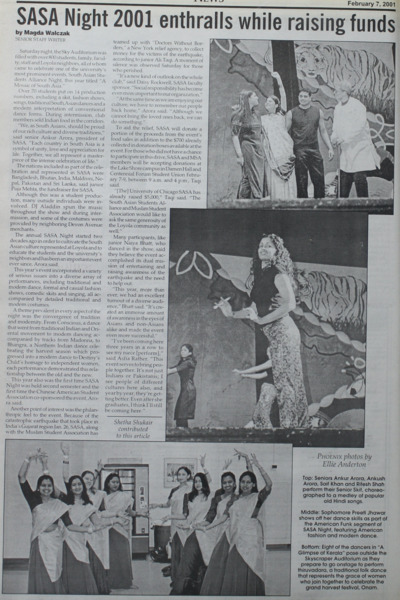
An article by Madga Walczak, senior staff writer of the Loyola Phoenix, reports on the annual South Asian Students Alliance Night 2001, titled "A Mosaic of South Asia." Over 800 students, family, faculty, staff, and Loyola neighbors attended at the Sky Auditorium.
"Over 70 students put on 14 production numbers, including a skit, fashion shows, songs, traditional South Asian dances and a modern interpretation of conventional dance forms. During intermission, club members sold Indian food in the corridors.
'We, as South Asians, should be proud of our rich culture and diverse traditions,' said senior Ankur Arora, president of SASA. 'Each country in South Asia is a symbol of unity, love and appreciation for life. Together, we all represent a masterpiece of the intense celebration of life.'
The nations included as part of the celebration and represented in SASA were Bangladesh, Bhutan, India, Maldives, Nepal, Pakistan, and Sri Lanka, said junior Puja Mehta, the fundraiser for SASA.
Although this was a student production, many outside individuals were involved. DJ Aladdin spun the music throughout the show and during intermission, and some of the costumes were provided by neighboring Devon Avenue merchants.
The annual SASA Night started two decades ago in order to cultivate the South Asian culture represented at Loyola and to educate the students and the university's neighbors and has been an important event ever since, Arora said."
"A theme prevalent in every aspect of the night was the convergence of tradition and modernity. From Conscious, a dance that went from traditional Indian and Oriental movement to modern dancing accompanied by tracks from Madonna, to Bhangra, a Northern Indian dance celebrating the harvest season which progressed into a modern dance to Destiny's Child's homage to independent women, each performance demonstrated this relationship between the old and the new."
This was also the first year it was co-sposored by the Chinese American Student Association.
"Another point of interest was the philanthropic feel to the event. Because of the catastrophic earthquake that took place in India's Gujarat region Jan. 26, SASA, along with the Muslim Student Association has teamed up with 'Doctors Without Borders,' a New York relief agency, to collect money for the victims of the earthquake, according to junior Ali Taqi. A moment of silence was observed Saturday for those who perished.
'It's a new kind of outlook on the whole club,' said Daisy Rockwell, SASA faculty sponsor. 'Social responsibility has become even more important to our organization.'
'At the same tme as we are enjoying our culture, we have to remember our people back home,' Arora said. ' Although we cannot bring loved ones back, we can do something.'"
SASA donated the proceeds from food sales and donations collected in boxes. Students noted the high turnout and diverse audience.
Three photos accompany the article, from top to bottom they show four seniors performing their Senior Skit (choreographed to a medley of popular old Hindi songs), Sophomore Preeti Jhawar showing off her dance skills in the American Funk segment, and eight of the dancers in 'A Glimpse of Kerala' posing outside the Skyscraper Auditorium before going onstage to perform thiruvadara, a traditional folk dance that represents the grace of women who join to celebrate the grand harvest festival, Onam.
Item 1: Full article
Item 2: Collage of two photos
-
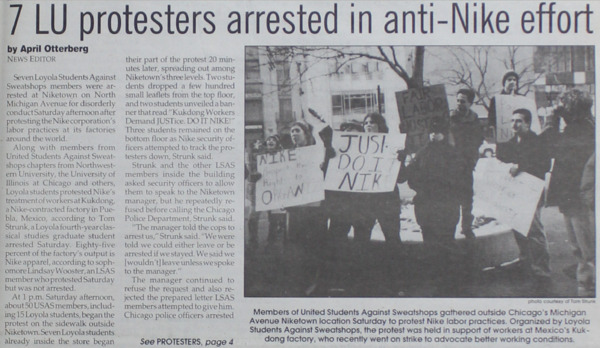
An article in the Loyola Phoenix, featuring a photo of student protesters holding signs protesting sweatshop labor.
The article reports:
"Seven Loyola Students Against Sweatshops members were arrested at Niketown on North Michigan Avenue for disorderly conduct Saturday afternoon after protesting the Nike corporation's labor practices at its factories around the world.
Along with members from United Students Against Sweatshops chapters from Northwestern University, the University of Illinois at Chicago, and others, Loyola students protested Nike's treatment of workers at Kukdong, a Nike-contracted factory in Puebla, Mexico, according to Tom Strunk, a Loyola fourth-year classical studies graduate student arrested Saturday. Eighty-five percent of the factory's output is Nike apparel, according to sophomore Lindsay Wooster, an LSAS member who protested Saturday but was not arrested.
At 1 p.m. Saturday afternoon, about 50 USAS members, including 15 Loyola students, began the protest on the sidewalk outside Niketown. Seven Loyola students already inside the store began their part of the protest 20 minutes later, spreading out among Niketown's three leels. Two students dropped a few hundred small leaflets from the top floor, and two students unveiled a banner that read 'Kukdong Workers Demand JUSTice. DO IT NIKE!' Three students remained on the bottom floor as Nike security officers attempted to track the protesters down, Strunk said.
Strunk and the other LSAS members inside the building asked security officers to allow them to speak to the Niketown manager, but he repeatedly refused before calling the Chicago Police Department, Strunk said."
The protesters were told they could leave or be arrested, and they replied that they would stay until they spoke to a manager. The manager refused and rejected their prepared letter. Chicago police officers arrested some of the protesters.
Item 1: Page 1 of the article
Item 2: Detail of the photograph
-
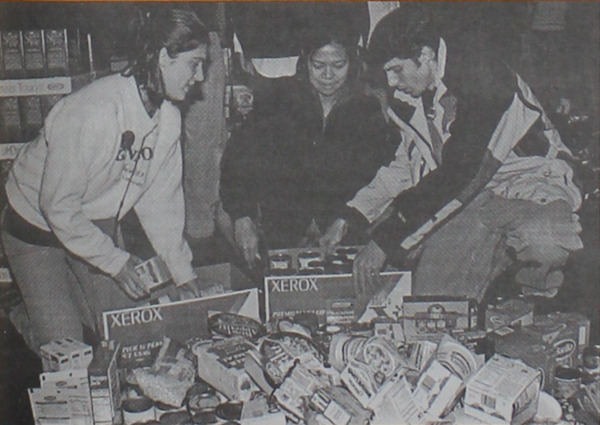
Three volunteers participate in the Gannon Scholars' sixth annual Gannon Reach Out food drive, raising over $6,000 to provide Thanksgiving dinners to families in the Rogers Park and Edgewater communities who otherwise would not be able to celebrate Thanksgiving. The Gannon Scholars are women student leaders at Loyola. The Reach Out motto was "Extending hearts and hands."
Over 150 students, faculty, and staff gathered for the program that was organized by 16 Gannon Scholars. The Scholars solicited donations of time and money from 59 local businesses, as well as Loyola organizations, and members of the Loyola community. Gannon Scholar Kendra Preston said she felt the program allowed people to learn about hunger in Loyola's neighborhood as well as to do something to ease that problem. Friday, volunteers organized the food into boxes and created Thanksgiving cards, then on Saturday morning they delivered the boxes to individual families. A speaker from the Howard Area Community Center spoke to volunteers about the causes of poverty and restrictions on welfare eligibility. Gannon Reach Out started in 1995 and served 25 families by raising $700 in its first year. By 2000, they had distributed $30,000 in food.
Photo by John Grimaud
-

An article discusses the Loyola women's volleyball team (the Ramblers) and their recent win of the MCC, which put them in the finals for the NCAA Tournament for the second year in a row. Coach Liz Nelson said "We were simply unstoppable this weekend... This is how we wanted to be playing right now. One of our goals, as coaches, was to have the team playing its best when the postseason rolled around. And the way we played this weekend, no one could have beaten us." A photo shows the team posing after their victory, and another photo shows the team in action against a rival team. Item 1: Article
Item 2: Close-up crop of the second photo
-
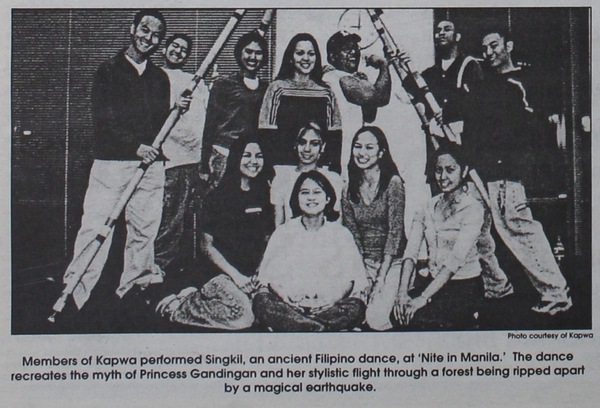
This photo appears in an article covering a festival of dance and tradition hosted by Kapwa, Loyola's Filipino Student Organization. The title was "Nite in Manila: Celebrating the Past, Envisioning the Future." It was held on Saturday, October 26 in the Rambler Room at Loyola.
Kapwa members showcased 11 cultural dances and customs to highlight Filipino and Filipino American culture and express hope for the future. Over 100 Loyolans and others attended, and senior Diana de Dios (Kapwa president) and senior Ryan Casaquite hosted. The show was "a significant finale to Filipino American Heritage Month."
As the article says, "Singkil, one of the most ancient Filipino dances performed at the show, is based on the epic legend of the 'Darangan' of the Maranao people of Mindanao. The legend places Princess Gandingan in the middle of a forest during an earthquake caused by a group of magical fairies. The dancer must rhythmically avoid falling bamboo poles, among other obstacles, before being saved by the prince." The hosts interviewed dancers between performances about culture and current events. They discussed prejudice against Asian Americans, and hoped the evening would bring awareness to such issues of how America sees Filipinos. They also used light-hearted dances to look at the lighter side of Filipino culture.
-

(from top left to bottom right) The icons of social media platforms: Facebook, YouTube, Twitter and Instagram.
This collage was created in 2020 for Loyola at 150 Timeline project.
-

Original caption: Remains of the World Trade Center in New York City.
-
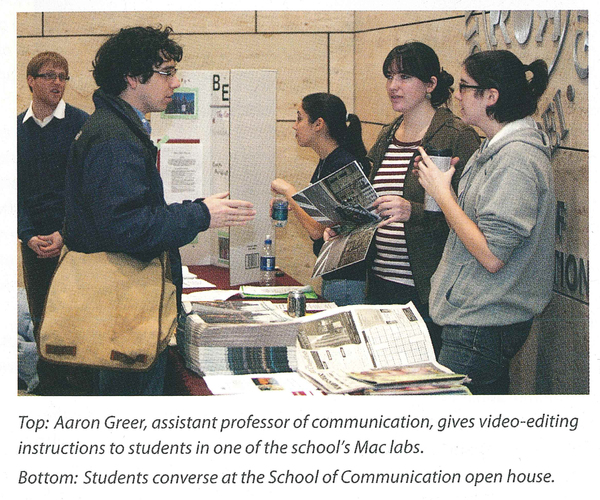
Students converse with one another at the School of Communication open house. Various pamphlets, brochures and a pop-up display can be seen on the table of the booth.
-
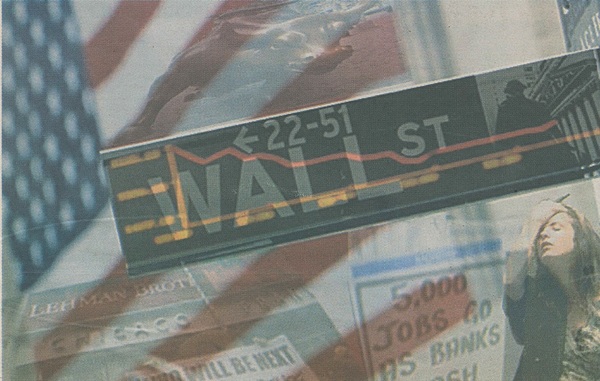
The image is a collage of superimposed images featuring (from top left to bottom right) the American flag, the street sign of Wall Street, the facade of Lehman Brothers, a sign declaring that "5,000 jobs go as banks [indecipherable]" and an individual clapping a hand to their forehead with their eyes closed.
The Loyola Phoenix ran two articles on the financial crisis in this issue. One covered the panel discussion held at Loyola's School of Business on the mortgage crisis and proposed bailout while the other covered how the topic of the financial crisis had entered classroom discussions at Loyola. A timeline of the financial crisis, the proposed bailout and its defeat in the House of Representatives is also included on page 6.
-
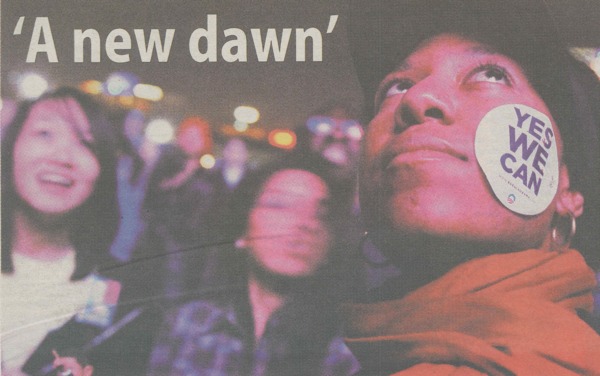
Chinyere Brown, with a "Yes We Can" sticker on their cheek, looks up. Two other unidentified individuals, one cheering, can be seen in the background. This is the cover image for the article "Obama elected president."
The caption reads: Yes we did - Chinyere Brown, a 27-year-old auditor, watches as Barack Obama is declared the winner of the presidential election.
The article describes the events at the Grant Park rally on and also details the reactions of participants to Obama's being declared the President-elect.
-
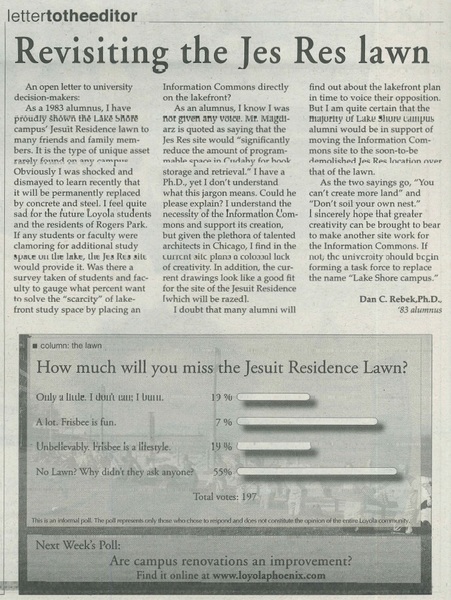
This letter to the editor, penned by alumnus Dan C. Rebek, Ph.D, '83, expressed Rebek's dismay at the pending removal of the Jesuit Residence Lawn. Rebek also questioned whether students had been surveyed prior to the planned removal, stating that alumni did not seemed to have been given any say in the matter. The article also features a poll on the question "How much will you miss the Jesuit Residence Lawn?"
-
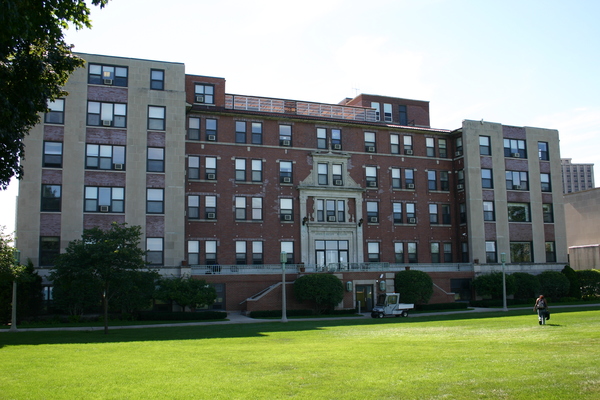
The Jesuit Residence, built in 1922 as the Administration Building, and the Jesuit Residence Lawn are depicted in this picture. The Information Commons now sits at the site of the Jesuit Residence, which was demolished in 2008. The lawn was also removed in 2008. Many students and alumni expressed dismay at the latter's removal.
-

This article covers the process of how College Advocates of Reproductive Education (CARE), an organization whose goal was to provide resources on reproductive health for students, gained official status as a university organization. There are also details of the organization's planned activities and collaboration with the Wellness Center.
-
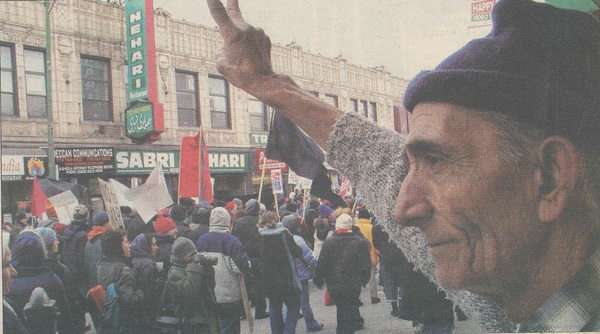
The image shows an elderly protestor signing from the sideline to a large crowd marching down Devon Avenue. The caption reads: A protestor signs to the crowd Saturday during the march down Devon Avenue. Many international cities hosted some protestors, with London drawing the most at over 1 million.
The image is part of a two-page article on the demonstrations against the pending Iraq War in Chicago. The article also included details of Chicagoan students' reactions toward the pending war as well as discussions of how the pending war had entered classroom discussions and led to military reserves being called to active duty. Loyolan students interviewed expressed a range of opinions about the pending war, from pro-war sentiments to indifference.

























